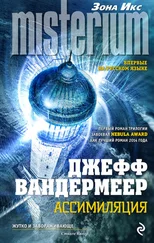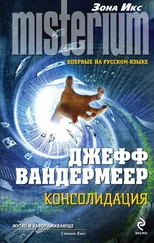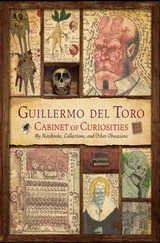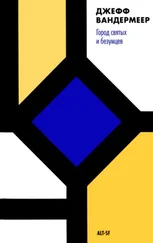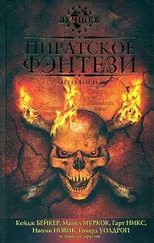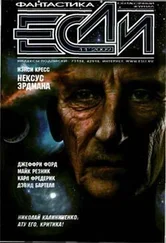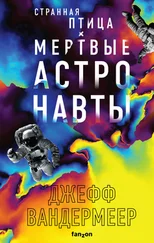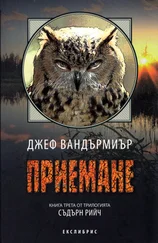Джефф Вандермеер - The Thackery T. Lambshead Cabinet of Curiosities
Здесь есть возможность читать онлайн «Джефф Вандермеер - The Thackery T. Lambshead Cabinet of Curiosities» весь текст электронной книги совершенно бесплатно (целиком полную версию без сокращений). В некоторых случаях можно слушать аудио, скачать через торрент в формате fb2 и присутствует краткое содержание. Жанр: Фэнтези, на английском языке. Описание произведения, (предисловие) а так же отзывы посетителей доступны на портале библиотеки ЛибКат.
- Название:The Thackery T. Lambshead Cabinet of Curiosities
- Автор:
- Жанр:
- Год:неизвестен
- ISBN:нет данных
- Рейтинг книги:5 / 5. Голосов: 1
-
Избранное:Добавить в избранное
- Отзывы:
-
Ваша оценка:
- 100
- 1
- 2
- 3
- 4
- 5
The Thackery T. Lambshead Cabinet of Curiosities: краткое содержание, описание и аннотация
Предлагаем к чтению аннотацию, описание, краткое содержание или предисловие (зависит от того, что написал сам автор книги «The Thackery T. Lambshead Cabinet of Curiosities»). Если вы не нашли необходимую информацию о книге — напишите в комментариях, мы постараемся отыскать её.
The Thackery T. Lambshead Cabinet of Curiosities — читать онлайн бесплатно полную книгу (весь текст) целиком
Ниже представлен текст книги, разбитый по страницам. Система сохранения места последней прочитанной страницы, позволяет с удобством читать онлайн бесплатно книгу «The Thackery T. Lambshead Cabinet of Curiosities», без необходимости каждый раз заново искать на чём Вы остановились. Поставьте закладку, и сможете в любой момент перейти на страницу, на которой закончили чтение.
Интервал:
Закладка:
Aquilus, though, was a force and a character in her own right: a groundbreaking neuroscientist and surgeon in an era when females in those fields were unheard of; a researcher who worked for the British government during World War II to perfect triage for traumatic head wounds on the battlefield; and a champion at dressage who combined such a knack for negotiation with forcefulness of will that for a time she entered the political sphere as a spokesperson for the Socialist Party. Possessed of prodigious strength, she could also “shoot like a sniper” and “pilot or commandeer any damn boat, frigate, sampan, freighter, destroyer, or aircraft carrier you care to name,” Lambshead wrote admiringly in a late 1950s letter to Moorcock.
All that ended in the one-car accident that left Lambshead in shock and Aquilus dead, her remains cremated and buried in a small, private ceremony almost immediately thereafter. Lambshead would never remarry, and often spoke of Helen as if she were still alive, a tendency that friends at first found understandable, then obsessional, and, finally, just “a quirk of Thackery’s syntax,” as Moorcock put it.
From 1963 on, however, despite his journals containing any number of elaborate descriptions of medical exploration and of artifacts acquired or sent off, there is only one mention of Helen. “Helen chose a different life,” he writes in 1965, on the anniversary of her accident. The words are crossed out, then reinstated and emphasized overtop of the cross-out, with a violence that has torn the page, and several pages after, so that many entries thereafter are marked by and linked to that one sentence.
What to make of the statement “Helen has chosen another life”? Since 2005, when the journals first became available to the public through the British Library, many a researcher has attempted to make their reputation on an interpretation—everything from psychological profiling to outright conspiracy theories. Riffing off of the ideas, if not the political inclination, of the second endnote in Reza Negarestani’s “The Gallows-horse” (see: The Miéville Anomalies), unexplained-phenomena enthusiast and self-described “heretic Lambsheadean” Caitlín R. Kiernan has speculated that “Helen Aquilus did not die in a car crash in 1960. She staged her own death to join a secret society devoted to radical progressive change in the world, and spent the next half-century of her life in that struggle until a car bomb in Athens took her life in 2005, the body unclaimed for forty-eight hours and then mysteriously disappearing.”
Evidence for this claim is flimsy at best, although Kiernan cites the speedy cremation of the body, the lack of any follow-up report, “due to the actions of a sleeper cell” within the police department, and “a damning history of collusion between the timing of Lambshead’s museum loans/artifact purchases and the movements of known spies and double agents in the area. It must be assumed that encoded into such transactions were secret messages, some of them from Helen and some of them from Lambshead to Helen.” Kiernan also notes the rapid reversal of some museum loans; in one case, involving “The Armor of Saint Locust,” Lambshead rescinded his approval for the loan five days after the exhibit had opened to the public. She also references “the timing of Lambshead’s visits to the Pulvadmonitor” (see: “Pulvadmonitor: The Dust’s Warning,” The Mignola Exhibits).
Kiernan saves her most pointed commentary for specific evidence: the rolled-up piece of parchment found inside a mechanical rhino in Zurich in 1976. “The text and image on this paper is ostensibly a maskh spell for constructing a pod for a journey toward the afterlife of the Elysian Fields. The spell is comprised of four main elements: a body wrapped in a shroud, one square and one rectangular chart, and lastly a scorpion, which in Middle Eastern folklore and talismans plays the role of a delivery system or a catalyst (here the scorpion is the engine for the pod to the afterlife). The dimensions of the pod (the shrouded body) have been given in the spell. The word ‘scorpion’ in Farsi has been hidden in this spell in the form of a cipher that looks like an abstract scorpion (the mark just above the word ‘Elysian’ at the bottom of the drawing). But what’s also been hidden here, encrypted, is a series of messages from a husband to his wife that, if ever properly deciphered, would no doubt prove to be a hybrid of a love letter and a complex series of orders or recognition of receipt of commands that might have agency over several years, if not decades. That is the true scorpion in this image.”
All of this “information” has been gleaned from what Kiernan calls “further encrypted evidence in Lambshead’s journals from 1965 on—the year he learned that Helen wasn’t dead—and supported by such circumstantial evidence as their heated public argument in 1959,” also documented in the journals, in which Lambshead confesses, with no small amount of anguish, that “Helen is much more radical than I could ever be. How am I supposed to follow her in that?” Kiernan points to Lambshead’s writings on “the second life of artifacts” in his “The Violent Philosophy of the Archive,” which she claims “isn’t about the objects at all, but about their repurposing by him.”
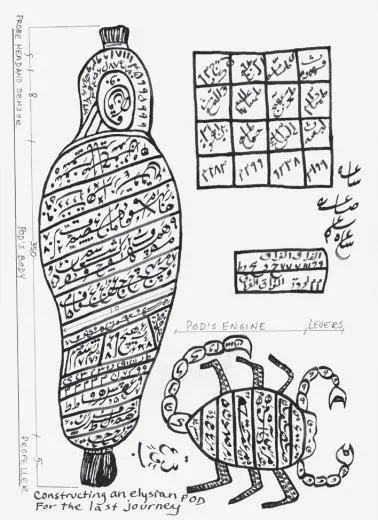
Spell or secret communication? The page found inside of the mecha-rhino, as photographed by Zurich investigator Kristen Alvanson.
Kiernan further claims that Helen attended Lambshead’s funeral, “the mysterious woman in white standing at the back, next to Keith Richards and Deepak Chopra.” However, photographs from the funeral clearly show many older women “standing at the back,” several of them mysterious in the sense that they cannot be identified and are not on the guest list.
A theory put forward by Alan Moore, who knew Lambshead late in life better than anyone, is more reasonable and doesn’t presume conspiracy and collusion. Moore suggests merely that the hectic pace Lambshead set from 1963 until his death in 2003 came from a sudden resolve: “It was merely one of the oldest stories, you see. A man attempting to outrun the knowledge of the continuing absence of the love of his life.” (In the subtext of his pornographic masterpiece The Lost Girls, Moore would reference both Lambshead and Helen, through the device of a mirror separating them forever.)
Loans with Strings Attached: The Museum Exhibits
Of all of Kiernan’s “evidence,” the most fact-based concerned Lambshead’s eccentric attitude toward the visual documentation of the contents of his cabinet, whether parts of it were at home or roaming abroad. Although it’s hardly evidence of secret messages being included with his loans, Lambshead usually forbid even the usual photographs a museum will commission for catalogs or postcards. His sole recorded explanation? “It creates greater anticipation if the public has no preconceived idea of what they may be about to encounter. A photograph is a sad and lonely idea of an echo of something real.” ( Guardian, “Sir Ranulph Wykeham-Rackham. a.k.a. Robotikus, Still on Loan to Imperial War Museum, But Nowhere to Be Seen,” June 4, 1998)
However, as even the barely suppressed emotion evidenced by the quote may suggest, it seems more likely that Lambshead’s intense personal commitment to the core collection made the loaning of items, while necessary and part of what the doctor considered his “civic duty,” also painful, and that forbidding photographs gave him a measure of control, a way he could allow the public to experience his cabinet and yet keep it from the Public Eye. As might be expected, the compilation of a book chronicling highlights from Lambshead’s cabinet has been made much more difficult due to this eccentricity.
Читать дальшеИнтервал:
Закладка:
Похожие книги на «The Thackery T. Lambshead Cabinet of Curiosities»
Представляем Вашему вниманию похожие книги на «The Thackery T. Lambshead Cabinet of Curiosities» списком для выбора. Мы отобрали схожую по названию и смыслу литературу в надежде предоставить читателям больше вариантов отыскать новые, интересные, ещё непрочитанные произведения.
Обсуждение, отзывы о книге «The Thackery T. Lambshead Cabinet of Curiosities» и просто собственные мнения читателей. Оставьте ваши комментарии, напишите, что Вы думаете о произведении, его смысле или главных героях. Укажите что конкретно понравилось, а что нет, и почему Вы так считаете.

